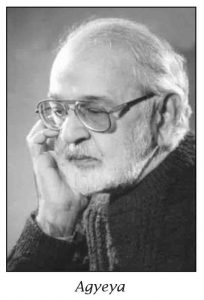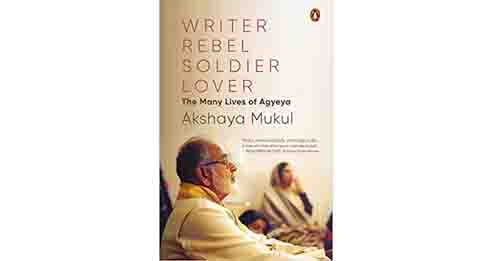An excerpt from Writer, Rebel, Soldier, Lover: The Many Lives of Agyeya by Akshaya Mukul (2022) pages 20-24.The Madras of 1920s was where Sachchidanand Hirananda Vatsyayan – later famous as the Hindi writer “Agyeya” — had his first real experience of caste.
Sachchidanand arrived in Madras in June 1925, aged fourteen, following his elder brothers to the Madras Christian College (MCC) for an intermediate degree in science. While Sachcha had been exposed to different periods of history in various parts of India, he had been thus far largely sheltered. As the son of an officer in the colonial government, he had been kept away from the politics of the time. The conservative city of Madras was just the place for an introduction, particularly to the resistance of non-Brahmin communities against the upper-caste stranglehold on the socio-political sphere.

A few years earlier, the politically tumultuous 1920s had seen the first general election to the Imperial Legislative Council, the new bicameral legislature that allowed Indians to participate. Gandhi and the Non-Cooperation Movement gained momentum in the following years. Particularly in the Madras Presidency, the Congress party—though still at the helm of the anti-colonial national movement—was facing a serious existential crisis over its ambivalence about caste and its call to boycott the new legislative bodies.
The social revolutionary E.V. Ramasamy, better known as ‘Periyar’, presented the greatest challenge to the Brahmin hegemony in Congress and in politics generally. A member of the Balija trading community and a former mendicant, Periyar was at the forefront of the party’s temperance movement and had succeeded in making Erode, his hometown, fully dry. But his insistence on resolutions that would ensure political representation for non-Brahmins led to growing tension with the Congress leadership. Periyar finally left the party in November 1925, going on to dominate the politics of Tamil Nadu with his slogan of ‘no god, no religion, no Gandhi, no Congress and no Brahmins’.
The MCC was not impervious to tensions over caste and religion. The institution had roots in the Free Church of Scotland, and after various transformations, emerged in 1877 as a cooperative administered by six different churches. Despite this missionary history, caste and religious conflicts arose even in its earliest days as a school in the mid-1800s.
In the years leading up to Sachcha’s arrival, the college authorities were increasingly concerned about students becoming a resource for political mobilization by different political parties. They worried when students welcomed nationalist Bipin Chandra Pal in 1907; such interests apparently went against the purpose of attending MCC, namely structuring ‘life’s opportunities for successive cohorts of ambitious and able young men over many decades’. There were no major upheavals around religion, caste or politics at MCC during Sachchidanand’s two years there. However, several small incidents formed his first real experience of caste and awareness of his own privilege as a Brahmin. Hirananda had enforced their Brahminical identity at home, but full-fledged segregation was something his young son found unpalatable when he first encountered it at MCC.
Upon his arrival, Sachchidanand was assigned to the First Student Home, a Brahmin-only dormitory for forty-six students on Thambu Chetty Street, complete with tennis courts where he could play his favourite sport. On the campus, he saw Brahmin students mixing freely with non-Brahmins and European teachers—yet never forgetting to wash their hands after each handshake. If a man from a lower caste passed by the dining hall and happened to look in, the Brahmin students would rise up, abandoning their plates. ‘It seems that if a low caste man looks at your food it is defiled, almost as if a dog had come and eaten part of it,’ Sachchidanand noted. ‘Though dogs sometimes do come into the hall and are shooed out without making any difference.’
Even the north Indian Anand brothers were barely tolerated. Residents of the First Student Home acknowledged that they were Brahmins, but where was the sacred thread? Where was the sacred tuft and when did they say their sacred prayers? These students could not fathom how the brothers could waste their ‘one gift of caste’, and prophesied that Sachcha and his brothers might take the form of dogs, crows or worms in their next lives. They would not ‘hurl their own sacred selves to perdition by dining with us’, Sachcha remembered. He considered them ‘hypocritical thugs’.
The situation improved as the First Student Home residents slowly yielded to the brothers’ ‘non-Brahmin’ ways. But after two months, Sachcha had had enough and decided to move out. ‘I am not the kind that will stay where I am merely tolerated, though I might obstinately stay on where my presence is actively resented, just for the joy of it,’ he wrote. ‘As soon as we have established our right to stay there, I have lost all desire to stay, and leave for another hostel in which this evil spirit of caste does not rave maniacally.’
He moved to the relatively new College Park Hostel, established in 1919, about eight kilometres from the college. The property was bequeathed to the MCC by William Miller, the fourth and most prominent principal, who had also built the First Student Home. Miller envisioned two hostels: a mixed residence for Brahmins and non-Brahmins, and another exclusively for Christians. In practice, there were three different messes run by the students: Brahmin, non-Brahmin and Christian. Sachchidanand moved to the non-Brahmin hostel and mess. There he could avoid ‘caste snobs’ and ‘rub shoulders and exchange plates not [only] with low caste folk but with untouchables’.
The looser atmosphere of his new hostel was a relief. ‘If my soul must rot in perdition, let it. If I shall be born again as a creeping worm, let me,’ he wrote. ‘I must live among those whom everyone despises, be one of them, choose from among them friends who will last me a lifetime and beyond.’ A vegetarian since birth, Sachcha now lived with non-vegetarians, and over the next few years, also began eating meat.
Outside the college, Brahmin supremacists were everywhere. Sachchidanand had heard ‘extravagant stories’ about the ‘potence of caste in Malabar’. During a vacation on the south-west coast, he saw how certain roads were not open to low-caste travellers, how a low-caste man had to cross a river by ferry as bridges were mostly reserved for the high castes, how an untouchable could not buy land in a Brahmin neighbourhood. He noted that an untouchable had to raise his hand and shout ‘unclean’ like a ‘leper when he came in sight of any Brahmin so that the latter might not be defiled by coming too near’.
A particular incident from the trip stayed with him, finding a significant place in Shekhar: Ek Jiwani. One evening, Sachchidanand was walking towards the Arya Samaj Mission, where he was staying, when he heard a moan from the side of the road. He turned to see a ‘battered lump of flesh and blood which must have once been a woman’. The lump was ‘alive and moaning painfully’. He brought her to the Arya Samaj, where she was given medical assistance, but it was too late. She died the next morning. The coroner pronounced ‘Death due to violent hurt, caused by sharp missiles. Motive of murder unknown.’ This report led to nothing, but it ‘gave her name and caste. She was an untouchable.’ Speculating about the incident a few years later, Sachchidanand wondered how many ‘high caste Brahmins must have deliberately defiled themselves in order to go near her and hit her’.
Staying with ‘untouchables, even miserables’ in Madras left a deep impression on him, finding its way to his dream diary and to Shekhar. ‘Some of the noblest characters I have known, some of the truest and most lasting friendships I have formed were among them,’ he wrote. Though guilty of a patronizing tendency to ennoble suffering, common to many well-intentioned members of privileged castes, Sachcha found in these friends a purity of heart, a freshness of mind and an enviable fire. ‘I alone mingled with them, got to know them, loved them and was glad,’ he said. These friendships fed his principles and caste continued to haunt his writing. ‘Someday perhaps in a violent cataclysmic upheaval, caste and creed shall die, and a new faith, Fraternity, arise,’ he wrote. ‘But not till then, not till then, and that day is not yet.’
Courtesy : FRONTLINE





